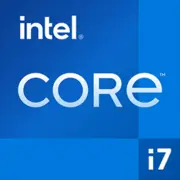Intel Core i7-1255U

インテル Core i7-1255U: モバイルデバイス向けのパワーとバッテリー寿命のバランス
2025年3月
2022年に発売されたインテル Core i7-1255Uプロセッサは、3年経ってもなおウルトラブックやビジネスノートPCにおいて魅力的な選択肢であり続けています。そのハイブリッドアーキテクチャAlder Lake、最新の標準への対応、そしてバランスの取れたパフォーマンスは、妥協のない動作を求めるユーザーにとって興味深い選択肢となります。この記事では、2025年にこのチップがどのようなユーザーに最適であるか、実際のタスクにおける性能、そしてその基盤となるデバイスを購入する際の注意点を詳しく解説します。
アーキテクチャとプロセス: ハイブリッドアプローチとインテル7
Core i7-1255Uプロセッサは、初めて2種類のコアを統合したハイブリッドアーキテクチャAlder Lakeをベースにしています: パフォーマンスコア(P-cores) と 効率コア(E-cores)。この設計は、負荷に応じたエネルギー消費とパフォーマンスの最適化を目指しています。
- コアとスレッド: 10コア(2 P-cores + 8 E-cores)および12スレッド。P-coresはハイパースレッディングをサポートし、4スレッドを提供しますが、E-coresはシングルスレッドモードで動作します。
- クロック周波数: P-coresのベースクロックは1.7GHz、最大ターボブースト時は4.7GHzまで到達します。E-coresは最大3.5GHzで動作します。
- プロセス技術: インテル7(以前は10nm Enhanced SuperFinとして知られていた)。これによりエネルギー消費を削減し、トランジスタの密度が向上しました。
- グラフィックス: 96のEU(実行ユニット)を搭載した統合型のインテル Iris Xe。これは4Kディスプレイをサポートし、AV1のエンコーディングが可能で、軽いゲームにも十分なパフォーマンスを提供します。
アーキテクチャの特長:
ハイブリッドシステムはタスクを分散させます: P-coresは「重い」アプリケーション(例えばPhotoshopやコードのコンパイル)を担当し、E-coresはバックグラウンドプロセス(更新、ストリーミング)を処理します。これにより全体的なエネルギー消費が削減されます。
エネルギー消費とTDP: モビリティのための15W
プロセッサのTDP(熱設計電力)は15Wであり、ウルトラブック向けのチップとして分類されます。ただし、ターボモードでは短時間に55Wに達することもあります。
- 実際のシナリオ:
- オフィス作業(ブラウザ、Word)の際、プロセッサは5-8Wを消費します。
- 負荷時(ビデオレンダリング)には25-30Wに達しますが、冷却システムが適切に機能する必要があります。
- 熱放散: コンパクトなノートPC(例えば、Dell XPS 13)では、負荷がかかるとチップが80-90°Cまで加熱する可能性がありますが、動的管理によって通常はスロットリング(周波数の低下)を回避できます。
アドバイス: レノボ ThinkPad X1 Carbonのようなデュアルファン冷却システムを持つノートPCを選ぶと、長時間のタスクでの周波数の安定性が向上します。
パフォーマンス: オフィス、メディア、ゲーム
オフィスタスク
- Geekbench 6: 1939(シングルスレッド)、6257(マルチスレッド)。これにより、特にExcelやブラウザのような単一コアに依存するアプリケーションで、i7-1255UはRyzen 7 5825U(1800/6000)よりも速くなります。
- 実際のテスト:
- Chromeで30タブを開きつつ、ZoomとSlackを同時に利用しても遅延なし。
- Adobe AcrobatでのPDF書き出し: i7-1165G7(Tiger Lake)より20%速い。
メディア
- 4Kビデオ: DaVinci Resolveで10分間の動画をレンダリングするのに約12分(Ryzen 7 5825Uの約15分と比較)。
- フォトエディタ: Lightroomにおける100枚のRAWファイルのバッチ処理は約8分。
ゲーム
- Iris Xe Graphicsは低設定でゲームをこなします:
- CS:GOでは60-70 FPS(1080p)。
- GTA Vでは40-45 FPS(720p)。
- より要求の厳しいプロジェクト(Cyberpunk 2077)にはeGPUが必要です。
ターボモード: 冷却が良好なノートPC(HP EliteBook 840)では、P-coresの周波数が4.3-4.5GHzで3分間持続し、その後3.8GHzに低下します。
使用シナリオ: このプロセッサは誰向け?
- 学生およびオフィスワーカー: バッテリー寿命が10時間程度の軽量ノートPC。
- フリーランスのデザイナー: 外出先でFigma、Lightroom、Premiere Proで作業可能。
- 旅行者: 1.2kg未満のデバイス(Acer Swift 5)。
向いていない人:
- ハードコアゲーマー — ディスクリートグラフィックスが必要。
- 3Dモデリングを行うエンジニア — Hシリーズ(例えばi7-12700H)を選んだ方が良い。
バッテリー寿命: エネルギー節約技術
- 稼働時間: 60W·hバッテリー搭載のノートPC(Asus ZenBook 14)では、混合使用で8-9時間を実現(明るさ50%、Wi-Fi)。
- エネルギー効率:
- Intel Dynamic Tuning 2.0: 負荷に応じてパワーを自動調整。
- Deep Learning Boost: より少ないエネルギー消費でAIタスク(Teamsでのノイズキャンセリング)を加速。
- アドバイス: バッテリー寿命を1.5-2時間延ばすために、電源設定でターボブーストをオフにしてください。
競合との比較
AMD Ryzen 7 5825U (Zen 3)
- プラス: マルチスレッド性能が優れている(8コア/16スレッド)、ノートPCの価格が低い(約$900対$1100)。
- マイナス: シングルスレッドの作業では劣り、Radeon VegaグラフィックスはIris Xeに劣る。
Apple M2
- プラス: バッテリー寿命が長い(最大15時間)、冷却性能が良好。
- マイナス: Windowsソフトとの互換性に制限あり、eGPUサポートなし。
Intel Core i7-1260P
- より強力なチップ(TDPは28W)だが、バッテリー持ち時間は20-30%短縮されます。
結論: i7-1255UはWindowsデバイスにおけるパフォーマンスとバッテリー寿命の間の最適な選択肢です。
長所と短所
強み:
1. 高いシングルスレッド性能。
2. Thunderbolt 4およびWi-Fi 6Eのサポート。
3. 要求の厳しくないゲームに対応できる十分なグラフィックス。
弱み:
1. Ryzen 7の16スレッドに対して12スレッド。
2. コンパクトなノートPCでは過熱の可能性。
3. 価格: i7-1255U搭載デバイスは$1000から。
ノートPCの選び方に関する推奨事項
1. デバイスタイプ: ウルトラブック(Dell XPS 13、Lenovo Yoga 9i)またはビジネスノートPC(HP EliteBook)。
2. 冷却: デュアルファンと熱管。
3. ディスプレイ: デザイナー向けに99% sRGBのIPSパネル。
4. バッテリー: 最低60W·h。
5. メモリとSSD: 最低16GBのLPDDR5と512GBのSSD。
2025年モデルの例:
- Acer Swift 5 (2025): $1200、1.1kg、14インチOLEDディスプレイ。
- Microsoft Surface Laptop 6: $1350、タッチディスプレイ、18時間のバッテリー寿命。
最終結論
2025年のインテル Core i7-1255Uは、プレミアムデザインの汎用ノートPCを求める人々に最適な選択肢です。その主な利点は次のとおりです:
- コンセントに依存せずに「重い」アプリケーションを処理できる能力。
- 最新のインターフェース(Thunderbolt 4、PCIe 4.0)のサポート。
- バッテリー寿命を延ばすハイブリッドアーキテクチャ。
このプロセッサは以下のような人に適しています:
- カフェや空港で頻繁に作業するフリーランサー。
- 技術専門の学生。
- 信頼性とポータビリティを重視するビジネスユーザー。
もし予算が限られているなら、Ryzen 7 5825U搭載のノートPCに目を向けてみてください。しかし、シングルスレッドタスクでの最大のパフォーマンスとプレミアムな体験を求めるなら、i7-1255Uはウルトラブックセグメントで最良の選択肢の一つであり続けます。
基本
CPUの仕様
メモリ仕様
GPUの仕様
その他
ベンチマーク
他のCPUとの比較
ソーシャルメディアで共有する
または当サイトへのリンクを追加
<a href="https://cputronic.com/ja/cpu/intel-core-i7-1255u" target="_blank">Intel Core i7-1255U</a>


